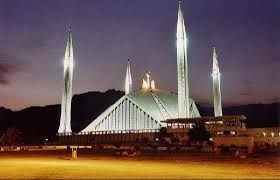Islamabad (Urdu: اسلام آباد, Islām ābād, Urdu pronunciation: [ɪsˌlɑːm ɑˈbɑːd̪]) is the national capital city of Pakistan located within the Islamabad Capital Territory. According to a 2012 estimate by the Census Department, the population of Islamabad including its surrounding territory has increased to 2 million[4] and together with its neighbouring twin city ofRawalpindi, the greater Islamabad-Rawalpindi metropolitan area is the third largest conurbation in Pakistan with a population of over 4.5 million inhabitants.[5] Since its foundation, Islamabad has attracted people from all over Pakistan, making it one of the most cosmopolitan and urbanised cities of Pakistan. As the national capital, Islamabad is the seat of the Government of Pakistan; the Presidential Palace (Aiwan-e-Sadr) is located here. Islamabad is also home to the Pakistan Monument, which is one of the two nationalmonuments of Pakistan. Islamabad is known as a clean, calm and green city. It hosts a large number of foreign diplomats, politicians and government employees.
Islamabad is a modern, planned and maintained city located in the Pothohar Plateau in the northeastern part of the country, within the Islamabad Capital Territory. The region has historically been a part of the crossroads of Punjab and Khyber Pakhtunkhwa with theMargalla Pass acting as the gateway between the two regions.[6] The city was built during the 1960s to replace Karachi as Pakistan's capital. Islamabad is a well-organised international city divided into several different sectors and zones. It is regarded as the most developed city in Pakistan and is ranked as a Gamma+ world city.[7] The city is home to theFaisal Mosque, the largest mosque in South Asia[8] and the fourth largest mosque in the world.[9][10]



